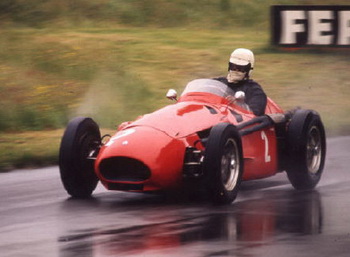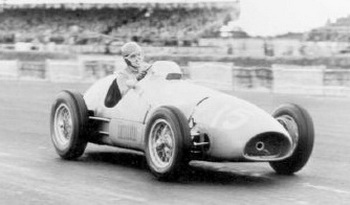

 |
|
Next month's
Bahrain Grand Prix will mark the beginning of the 60th
anniversary of F1 and three Italian winners from that
first decade - the Alfa Romeo 158 (top), Ferrari 500 F2
(bottom) and
Maserati 250F (middle) - will be honoured at the race. |
|
|
|
Next month's
Bahrain Grand Prix will mark the beginning of the 60th
anniversary of F1 and three Italian winners from that
first decade - the Alfa Romeo 158, Ferrari 500 F2 and
Maserati 250F - will be honoured at the race. On March
12-14 these three legends will join up to celebrate
Bahrain as the opening race of the 2010 season and to
mark the diamond anniversary of Formula One racing.
It was in
1950, after 44 years, two world wars and one abortive
attempt, that Grand Prix racing gained the honour of an
official world championship under the auspices of the
Fédération Internationale de l’Automobile. At the outset
much still remained of the sport’s origins, taking place
on circuits formed from closed public highways in Europe
and it was presided over by the last of the true grandee
teams: Alfa Romeo.
The
astonishing 1.5-litre supercharged type 158 ‘Alfettas’
were designed during 1937-38 and kept hidden in a
monastery during WW2, but emerged to dominate every
grand prix they entered. In 1950 the team was known as
the ‘three F’s’ for its driver line-up, consisting of
Italian aces Giuseppe Farina and Luigi Fagioli plus the
remarkable talent of the Argentinean driver Juan Manuel
Fangio. This trio were at their peak in time for the
first ever round of the World Championship; the British
Grand Prix which took place at Silverstone on May 13 1950. Under the
watchful eyes of King George VI, Queen Elizabeth, the
princesses Elizabeth and Margaret and up to a quarter of
a million fans, the world championship began as a
demonstration run for the ‘Three F’s’ from which Farina
would emerge victorious.
The Alfa
Romeo team remains statistically the most successful of
all time, losing only three races between 1945 and 1951,
and the 1950 Alfetta takes pride of place in the display
at the BIC throughout the celebrations.
Although Alfa
Romeo abandoned the sport at the end of 1951, a new superteam was already emerging. Enzo Ferrari had raced
for Alfa Romeo in the 1920s and through the next decade
established his privately-entered team under the name of
Scuderia Ferrari. After making a fortune producing ball
bearings during World War 2 Ferrari decided to become a
constructor in his own right and, at the 1951 British
Grand Prix, his 4.5-litre unsupercharged car became the
first to defeat Alfa Romeo in the hands of Argentinean
star José Froilan Gonzales. In 1952-53 Ferrari was
insuperable. Due to an
absence of Formula One machinery, the world championship
was held for Formula Two cars and in this smaller
category Ferrari was supreme thanks to its 500 F2 cars.
With the dazzling talents of Alberto Ascari leading the
team, Ferrari won 14 out of 15 races entered and one of
these gem-like cars will also be present at the BIC from
March 12-14.
In 1954-60
the 2.5-litre Formula One rules brought stability and a
raft of new constructors – among which the return of
Mercedes-Benz was far and away the most spectacular.
With its heritage of success dating back to the 1900s,
Mercedes had lain dormant since 1939. In 1954 the German
superteam was reborn; producing the innovative W196 car
and harnessing it to the magnificent talents of Juan
Manuel Fangio to dominate the next two seasons. One of
these all-conquering silver machines will be present to
witness the return of Mercedes-Benz after 55 years at
the 2010 Gulf Air Bahrain Grand Prix. Fangio remained
the single greatest talent in the sport, excelling on
the great road circuits such as Reims, Rouen, Monaco,
Pescara and Spa-Francorchamps.
After Alfa
Romeo and Mercedes he moved to Ferrari to win his fourth
title in 1956 and then in 1957 he won his fifth and
final championship with Maserati. In that 1957 season,
at the wheel of his Maserati 250F, Fangio drove races
that remain for many the finest ever seen. His final
career victory at the 1957 German Grand Prix came after
clawing back more than a minute on the leading Ferraris
in which the Maestro claimed to have driven beyond even
his own great powers and, fittingly, a Maserati 250F
will be at the BIC on March 12-14 in tribute.
As the 1950s
rolled on the races grew shorter, purpose-built race
tracks became more popular and a tide of British racing
green to begin flowing over the horizon. Having been a
minor player in the sport before 1939, the British
invasion of Grand Prix racing began when the insouciant
talents of Mike Hawthorn took him to Ferrari and then to
victory in the 1953 French GP. Hawthorn blazed the trail
and was followed into the winner’s circle by Stirling
Moss and Peter Collins, while British constructors BRM,
Vanwall, Connaught, Cooper and Lotus rose to prominence.
In terms of race wins nobody could touch Stirling Moss,
but fate decreed that the Formula One world championship
was never to be his. In 1958 it was Hawthorn won the
drivers’ title at the wheel of a Ferrari, although
Moss’s race wins ensured that Vanwall became the
inaugural winner of the Formula One constructors’
championship. In 1959 however there came a dramatic
change. The grand and elegant front-engined cars that
had dominated the sport since the 1900s were usurped by
a tiny little creation with the engine behind the
driver. British engineer John Cooper took inspiration
from the pre-war Auto Union cars to produce a lighter,
more nimble machine and with it the raw talent of
Australian racer Jack Brabham shone through. Brabham and
Cooper claimed the 1959-60 world championships and set a
new template for Formula One designs that remains to
this day.
“The 1950s
was an extremely charismatic era for the Formula One
World Championship,” said Shaikh Salman bin Isa Al
Khalifa, acting CEO of the Bahrain International
Circuit. “It is our pleasure and privilege to bring
together the cars of Alfa Romeo, Ferrari, Mercedes and
Maserati that won the titles in the sport’s earliest
years, and I am particularly looking forward to
welcoming Sir Jack Brabham to the Gulf Air Bahrain Grand
Prix on March 12-14 alongside his title-winning Cooper.”
|